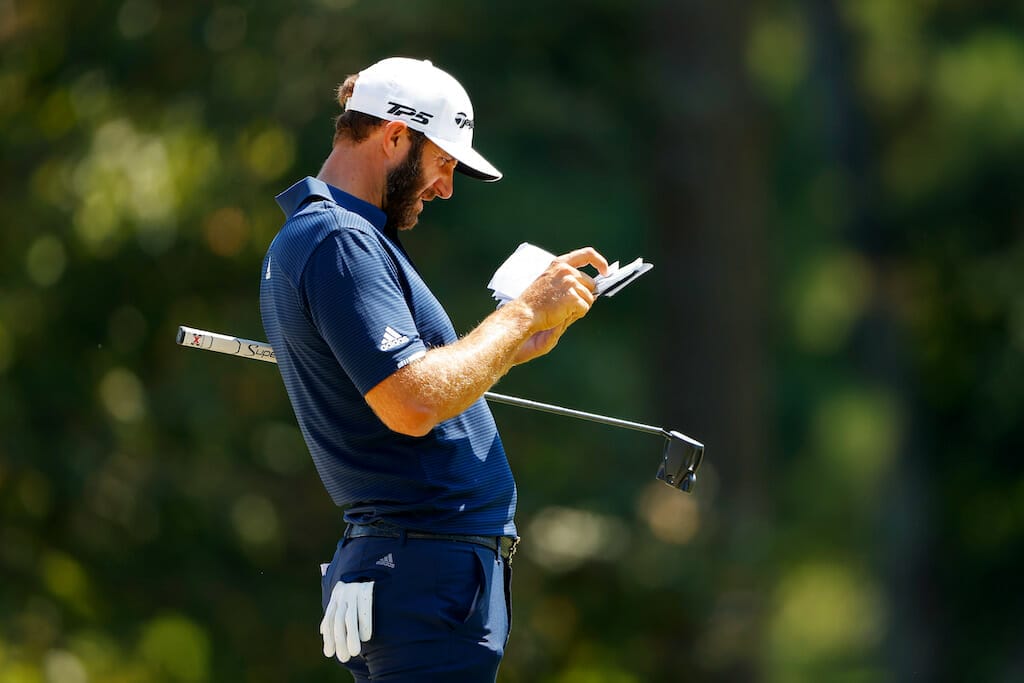It seems the wheels are in motion towards banning a real bugbear of the arm-chair golf fan – the infamous green-reading book.
Not quite the Sports Almanac that handed Biff Tannen his fortune in Back to the Future 2, but green-reading books have proved a real crutch for poor green-readers to lean on in recent years, allowing players to cash in whilst diminishing the art of green reading altogether.
According to a memo sent to caddies and players alike, a new regulation will be brought before the PGA Tour advisory board ahead of a January first implementation to “return to a position where players and caddies use only their skill, judgment and feel along with any information gained through experience, preparation and practice to read the line of play on the putting green.”
“Beginning in January I’ll no longer be able to use any of these greens books or YARDAGE books due to the changes the Tour has made to ban green reading material. What a waste of paper. R.I.P. yardage book collection.” — PGA Tour caddie Kyle Peters on the changes coming in 2022 pic.twitter.com/TJVwjYyQUZ
— Caddie Network (@CaddieNetwork) November 2, 2021
The idea is that players and caddies will only be allowed use a “Committee Approved” yardage book, containing “only general information on slopes and other features.”
As things stand, some players have been bowling with the bumpers up in recent years when it comes to putting, with technological advancements placing previously unseen levels of information conveniently into their back pockets.
Augusta National, to its credit, stands alone against green-reading books and guess what? Players struggle without them.
“It makes it harder. All I can do out here is judge with my eyes,” said Bryson DeChambeau of his Masters experience in 2019. “Is it as precise as the greens books? Absolutely not.”
My heart goes out to Bryson having to use his own eyes to read a putt. I’ve always preferred to use my ears to engage with the grass and wait for it to give me directions, but each to their own.
A common sight on PGA Tour broadcasts is an endless back and forth between players and their notes. Information overload has undoubtedly contributed to slow play on the greens and impacted the television spectacle as a whole.
Dustin Johnson is a wonderful putter but also a prime culprit when it comes to the incessant consulting of his green-reading book. It’s not that the book will guarantee success but much like Ron Burgundy relies on his teleprompter, the world number 3 can put his repeatable stroke on the science scribbled in his favourite novel and more often than not, he doesn’t fluff his lines.
But perhaps I shouldn’t be surprised it takes DJ so long to figure out his equations. Some of the green scanners used to document the subtleties of these surfaces for PGA Tour players can cost up to $120,000. In essence, the technology fires millions of laser beams against a mirror that casts them over the greens and I don’t want to get too technical here, but this process collects a shitload of data – three to four million bits worth in all of 10 minutes. So, it’s no wonder Johnson struggles. This is Ulysses for the golfer’s soul.
All things considered, you’d think a move towards banning these green-reading books would be an overwhelmingly positive intervention by the USGA and the R&A – should the Players Advisory Council accept it – but this is the rules of golf we’re talking about here, and therefore nothing is ever as easy as it seems.
“Handwritten notes that could assist with reading the line of play on the putting green will continue to be allowed in the approved book,” the memo reads.
“However, such notes will be restricted to only those made by the player or caddie and must be derived from the experiences or any observations of a ball rolling on a green. This includes observations from a TV broadcast. Transferring previous handwritten notes that also meet the new restrictions into the approved book is allowed.
“No devices, levels or other technology may be used to gather information to be kept as notes, and no information may be copied from another source into the approved book.”
What does all this mean? Well, no copying, no tracing, and no plagiarism, even if you’re plagiarising yourself. Your old green-reading book is contraband, the contents of which is not to be looked at, reused, or recycled. The notes you’re scribbling into your new pocketbook must be based on your own playing experiences at that particular course, and if you don’t have time to get there, then you can also jot down your observations from watching said course on TV. It’s 2021 baby. The PGA Tour lectures are online and recorded, so there’s no excuse to not do your homework.
You must be honest, because if you cheat on exam day, you’re only fooling yourself… not everyone else in these lucrative PGA Tour events where the smallest percentage gains are rewarded with monumental prizes.
Much like the ethics of golf have long relied upon the integrity of its participants, it seems the success of this latest rule in a game of many adopts the honour system, too.
After-all, who’s going to be cross-referencing a player’s new notebook against an old one to disprove the validity of the latest scribbles in the greens book? Will there be forensic analysis of live ink versus forgeries? Is the guy from Pawn Stars who authenticates the signatures now working for the PGA Tour?
As far as I can see, if a player says he’s made said note by playing a course or by watching it, we’re simply meant to take him at his word. And I’m fine with that, for what it’s worth, safe in the knowledge that the fraternal brotherhood of golf the almighty would never stoop to the point of manipulating the rules to their advantage.
Oh wait…
























Leave a comment